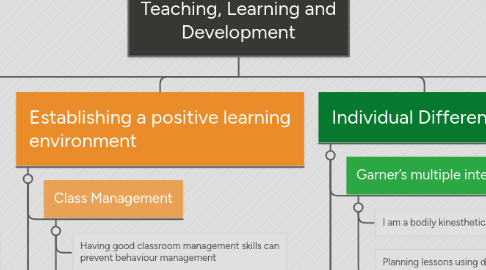
1. Planning for the upcoming school year
1.1. 10 Best Practices
1.1.1. My Favourites are:
1.1.2. -Teach for understanding, appreciation and life application (relate big ideas and apply them to real life situations)
1.1.3. -Foster metacognition and self-regulated learning (provide students the opportunity to create their own goals. Introduce metacognition)
1.1.3.1. -Recognize social aspects of learning (learning through socialization)
1.2. Best approach to teach
1.2.1. One of the best ways to teach a classroom is by getting to know who you’re students are. Learning about where they come from, their different cultures and practices, their learning abilities can help provide the educator with insight about how to approach teaching them.
1.2.2. Something I learned from my Teaching in Catholic Schools class was to always be prepared. Always have a back up lesson/activity in case your first plan fails.
1.3. Assessment before class
1.3.1. Assessing your student's prior knowledge can help you determine what you need to cover regarding curriculum
1.3.2. References Edmunds, A., & Edmunds, G. (2015). Educational Psychology, Applications in Canadian Classrooms, 2nd edition. Oxford University Press.
2. Individual Differences
2.1. Garner’s multiple intelligences
2.1.1. I am a bodily kinesthetic learner.
2.1.2. Planning lessons using differentiated instruction can address these types of intelligences
2.2. Recognizing the differences
2.2.1. Learning to recognize student’s exceptionalities and designing lessons to accommodate those needs
2.2.2. I feel recognizing the needs at a young age can make a huge difference for the student. They can get a healthy start to learning and have strategies that set them up for success but still challenge them academically.
2.2.2.1. “One in four students with ADHD also demonstrate executive function, working memory, and learning deficits that place them at high risk for academic failure…” (Edmunds & Edmunds, pg 209).
2.3. Bennett (2009) Including Students with Exceptionalities
2.3.1. segregating these students will not be beneficial for their learning. Taking them away from the regular classroom can have negative affects on their social skills, and ability to be integrated in a larger community. With the help of resource teachers parents and school administration, plans can be assessed for students to become successful.
2.3.1.1. References Bennet, S. (2009). Including students with exceptionalities. The Literacy and Numeracy Secretariat, 1-4. http://www.edu.gov.on.ca/eng/literacynumeracy/inspire/research/Bennett.pdf
3. Considering child and adolescent development
3.1. Nature vs Nurture
3.1.1. – Developing who you are from your biology and genes versus developing who you based on how you are raised.
3.2. Theorists
3.2.1. Piaget- Learning happens in stages, must complete the stage before moving onto the next
3.2.2. Vygostky- Zone of Proximal development- abilities a child can do with assisstance
3.3. Edmunds & Edmunds (2015)
3.3.1. “Human beings are born with an innately powerful curiosity about the world around them” (Edmunds & Edmunds, pg 47)
3.3.2. Importance of early language development- KEY for future success
4. Establishing a positive learning environment
4.1. Class Management
4.1.1. Having good classroom management skills can prevent behaviour management
4.1.2. Involve students in the process of creating expectations in the classroom
4.2. Behaviours vs Academics
4.2.1. “The absence of good behaviour is a performance-deficit problem, not a skill-deficit problem” (Edmunds & Edmunds, pg 110).
4.2.2. By getting to know your student’s need you can create strategies that help students stay focused or learn to cope with their emotions and behaviours
4.3. Community in the classroom
4.3.1. Create a space, free from judgment, bias, racism and bullying so children can feel safe and comfortable
5. Socio-Cultural Considerations
5.1. Cultural Awareness
5.1.1. Educators should be aware of different culture norms and practices and never who bias towards certain students. Educators should have cultural awareness and be open minded to new traditions and cultures.
5.1.2. Involving parents is a great way to build a relationship between home and the classroom
5.2. Stereotype threat
5.2.1. Stereotype threat can hinder a student’s ability to succeed. Constantly having the feeling of living up to a stereotype can cause stress to the student.
5.2.2. I feel children who are comfortable and confident with themselves will do better academically and socially than students who are not.
5.2.2.1. Chimamanda Ngozi Adichi (2009) The Danger of a Single Story. Judging someone based on stereotypes can be detrimental to the relationship you build with them.
5.3. Family Siutations
5.3.1. “Socio-economic status has by far the greatest impact on scholastic achievement”
5.3.2. Being an authoritative parent, who balances between being encouragement and discipline have the children who are more likely t be academically successful.
5.3.2.1. References TEDTalks. (2009, October). Chimamanda Ngozi Adichi: The Danger of a Single Story [Video file] Retrieved from https://www.youtube.com/watch?v=D9Ihs241zeg
